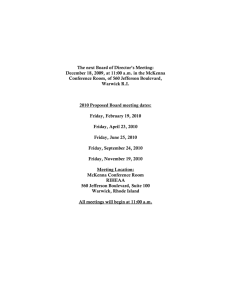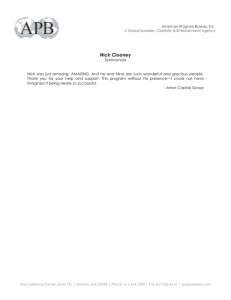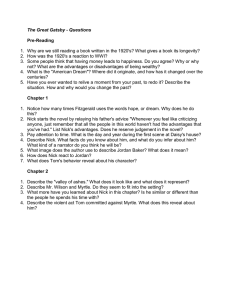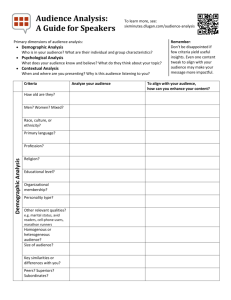Alignment for Large Engineering Projects: Architecting Distributed Leadership April 19th
advertisement
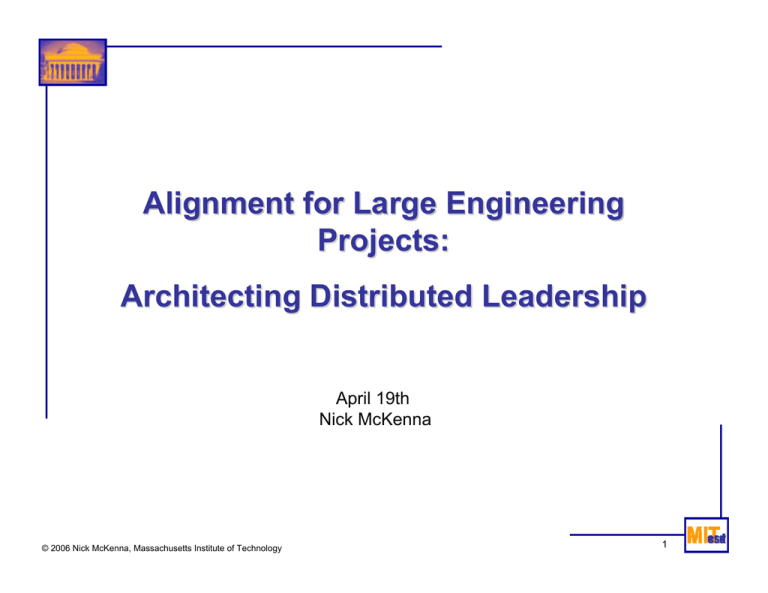
Alignment for Large Engineering Projects: Architecting Distributed Leadership April 19th Nick McKenna © 2006 Nick McKenna, Massachusetts Institute of Technology 1 Thunder Horse: A Large Project Ownership: BP (75%); Exxon (25%) Output: Oil: 200,000 b/per day Gas: 200 mil cubic feet/ day Location: 125 miles SE New Orleans Water Depth: 6000ft Product: 15,000psi, 270 degF Hull: DW 60,000t, Displ 130,000t Topsides: 20,000t Power generation: 100MW Accommodation: 185 persons Cost: $2 billion Completion: 2006 © 2006 Nick McKenna, Massachusetts Institute of Technology 2 The challenge of energy projects Large Engineering Projects are unique, dedicated, and usually one-off products with intensive interactions between sponsors and contractors1. Project Organization Sp2 Sp1 C4 C1 SC Delivering a unique product 1 SC requires a unique organization 3 SC 2 C2 C3 8 SC SC6 SC4 SC4 1 SC 7 SC SC5 1. Miller R., Lessard D., 2000, pg 7. © 2006 Nick McKenna, Massachusetts Institute of Technology 3 Different firms, different contracts © 2006 Nick McKenna, Massachusetts Institute of Technology 4 Contracts are Incomplete • Project sponsor assembles the required skills and assets through formal contracts. • Contracts for development projects are incomplete (can’t a priori specify a complete scope). • Much of the behavior that is required amongst firms is non-contractible: – Efficient provision of information – Knowledge building – Joint problem solving/decision making (joint consequence awareness) • Projects featured dispersed decision making under uncertainty. • Should we expect dispersed decision making to provide coherent outcomes? © 2006 Nick McKenna, Massachusetts Institute of Technology 5 Contracts are Incomplete • Projects frequently become adversarial amongst firms (Schedule delay, budget creep). – Multiple firms, multiple shareholders, stakeholders • Design the Formal Contracts: – Allocate Scope (Boundaries) – Allocate Risk – Metrics – Incentives, etc • To generate/support the development of successful “distributed leadership”. Where do we find successful examples of distributed leadership? © 2006 Nick McKenna, Massachusetts Institute of Technology 6 High Uncertainty, High Reliability Distributed Leadership in Action - High Reliability Organizations: • Nuclear Power Plants • Aircraft carrier Flight Operations • Offshore Operations Build trust, based on repeated interactions, situational awareness (shared consequences) – Distributed Decision Making Repeated However, usually within one Interaction organization. + Joint Problem R Solving/Consequence Awareness Trust Loop + How do we achieve it across Familiarity firm boundaries? + + By building “alignment”. Confidence/Trust © 2006 Nick McKenna, Massachusetts Institute of Technology 7 Project Enterprises: Product Systems Research Question in two parts: 1. What constitutes alignment amongst firms executing large engineering projects? 2. What policies or actions facilitate the generation of alignment? © 2006 Nick McKenna, Massachusetts Institute of Technology 8 Definitions of Alignment The correct position or positioning of different components with respect to each other or something else, so that they perform properly.2 Alignment can be defined as the condition where appropriate project participants are working within acceptable tolerances to develop and meet a uniformly defined and understood set of project objectives.3 Formal and informal patterns of interaction within and across inter-dependent stakeholders that serve to advance the separate and the collective interests of these stakeholders.4 2. http://encarta.msn.com/dictionary_/Alignment.html 3. Griffith A, F., Gibson G, E., 2001, Journal of Management in Engineering., pp 69 4. Cutcher-Gershenfeld J., Moses J., MIT Working Group on Alignment, Slide Deck March 2005. © 2006 Nick McKenna, Massachusetts Institute of Technology 9 Emerging theory of alignment A six factor model of alignment: • • • • • • System design Organizational design Contract design Risk Metrics Incentives Aligned firms build reinforcing trust-based mechanisms. “Trust based relationships are critical for success”. VP Engineering © 2006 Nick McKenna, Massachusetts Institute of Technology 10 How can we architect alignment? • ALIGN is a process that assists Project teams in generating alignment with contractors. • ALIGN is: – The ALIGN Implementation Guide (describes the process) – A set of ALIGN Workshops (Sponsor stakeholders, contractors) – The ALIGN Assessment Tool (tests extent of alignment and readiness) – The ALIGN Development Matrix (provides focus and captures actions) • ALIGN engages internal and external stakeholders and focuses on the need to design the organization along with designing the facility. © 2006 Nick McKenna, Massachusetts Institute of Technology 11 The Goals of Alignment • ALIGN delivers the goals of alignment 1. Project Goals: – Motivation towards advancing separate and collective interests – Collaborative project environments – Robust relationships based on trust and mutual respect 2. Longer Term Goals: – Sponsor positioned as the “customer of choice” © 2006 Nick McKenna, Massachusetts Institute of Technology 12 How does ALIGN work? • By generating specific actions tied to specific Areas of Focus – System Design – Organizational Design – Contract Design – Risk – Metrics – Incentives • Using ALIGN tools to identify the actions © 2006 Nick McKenna, Massachusetts Institute of Technology 13 How does ALIGN work? Sample Agenda for 2 day workshop DAY1 08.00-08.45 Introduction to ALIGN Workshop, ALIGN Goals and ALIGN Tools 08.45-09.15 Summary background to Development: key drivers, requirements, issues. 09.15-10.00 Review of contractor market place. 10.00-10.15 Break. 10.15-11.30 Initial ALIGN Assessment Tool session. 11.30-12.30 Lunch. 12.30-12.45 Recap and assign breakout sessions. 12.45-14.45 Breakout sessions with ALIGN Development Matrix. 14.45-15.00 Break . 15.00-17.00 Resume breakout sessions with ALIGN Development Matrix. 17.00-17.30 Wrap up for the day and set expectations for Day 2. Day 2 08.00-08.30 Copies of completed ALIGN Development Matrices from breakout sessions circulated. 08.30-10.30 Breakout Teams review Matrices for conflicts and misalignments with their groups & modify as appropriate. 10.30-10.45 Break . 10.45-12.30 Feedback from Breakouts (Revised Actions) 12.30-13.30 Lunch. 13.30-15.30 Review of proposed ALIGN Plan using ALIGN Assessment Tool (changes and gaps are captured, Actions assigned accountability). 15.30-16.00 Review of Workshop (including Feedback Questionnaires) 16:30 Wrap-up (Following Workshop Lead Facilitator provides electronic copy of ) Initial ALIGN Assessment Tool results Completed ALIGN Development matrices for each sector addressed. Copies of responsibility/accountability listings for each action item. List of Attendees Copies of Feedback Questionnaires. ALIGN Workshop © 2006 Nick McKenna, Massachusetts Institute of Technology 14 ALIGN Assessment Tool © 2006 Nick McKenna, Massachusetts Institute of Technology 15 ALIGN Template © 2006 Nick McKenna, Massachusetts Institute of Technology 16 How does ALIGN Development Matrix work? 1. Area of Focus Alignment Goals Collaborative Project Environments (Foster lateral alignment among contractors) Build LP Position as the "Customer of Choice" Area of Focus 3. To deliver these Goals Organizational Design Assign key executive level Focus on management of contact to manage and support interfaces/interdependencies. Assign resources and processes to lasting relationship and communication outside of assist communication and project team. integrated problem solving at organizational boundaries Actions 2. Using these actions © 2006 Nick McKenna, Massachusetts Institute of Technology 17 How can we build a robust relationship? © 2006 Nick McKenna, Massachusetts Institute of Technology 18 Integrating System Architecture and Organizational Architecture Organizational Architecture s s e DSM © 2006 Nick McKenna, Massachusetts Institute of Technology Pr P t c e oj c ALIGN o r System Architecture 19 Architecting Distributed leadership A 6 Factor ALIGN Model proposed to assist in identifying uncertainty and interdependence with respect to: Enterprise Decision Rights: • Objectives of System • Form of System • Utilization of Assets • Actions in response to measurement • Mitigation of Risk Leadership implies decision making. Distributed decision making requires a cohesive framework. © 2006 Nick McKenna, Massachusetts Institute of Technology 20 Questions? © 2006 Nick McKenna, Massachusetts Institute of Technology 21
